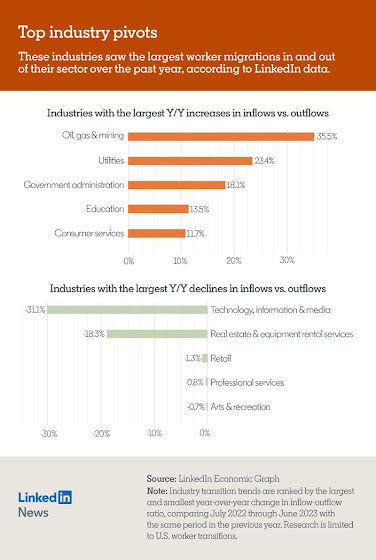Navigating the Changing Landscape of the Technology Sector: Challenges and Insights
The technology sector, known for its constant evolution, has been a driving force behind innovation and transformation across industries. Recent findings by LinkedIn's Economic Graph team have unveiled a significant shift in talent dynamics within the sector, with a substantial 31.1% decline in the ratio of talent inflows to outflows over the past year. This decline, the steepest across all industries, prompts an exploration into the underlying factors influencing this trend, particularly within the realm of the technology sector itself.
1) Decline in IT Requirements and Hardware Sales: Economic uncertainties and reduced purchasing power have undeniably impacted the technology sector. A sluggish demand for IT hardware in both commercial and personal spheres can be attributed to the economic downturn, which has constrained companies' abilities to invest in new technologies and forced them to prioritize existing resources.
2) Pandemic-Driven Over-Hiring: The unexpected surge in demand for digital solutions during the COVID-19 pandemic led to an unwarranted over-hiring frenzy within the technology sector. Many companies anticipated that the rapid pace of digitization seen during the pandemic would continue unabated. However, as the initial urgency waned, it became evident that the inflated workforce size did not align with actual requirements, resulting in a surplus of professionals with limited roles to fill.
3) Apprehensions Regarding Generative AI: A pervasive concern in both the technology and media sectors revolves around the emergence of Generative AI. The potential of this technology to automate tasks typically associated with lower technical complexity raises anxieties about job displacement. This concern has cast a shadow of uncertainty over professionals, influencing their decisions regarding career transitions and trajectories.
4) Diversified Innovation Across Fields: The allure of the technology sector has attracted talent from a multitude of fields, including finance, healthcare, and entertainment. As these industries invest more heavily in their technological capabilities, professionals may be enticed to explore opportunities beyond traditional IT roles. This pivot toward diverse skill sets reflects a strategic approach to staying competitive in an ever-evolving job market.
5) Extended Work Hours and Escalating Stress Levels: The rapid pace of the tech industry often translates into longer work hours and heightened stress levels. The advent of hybrid and remote work arrangements has further blurred the lines between personal and professional life, making it challenging for individuals to dedicate time to personal passions and hobbies.
6) Concerns about Job Security: The dynamic nature of the technology sector introduces an element of instability. Professionals within the sector are wary that the constant demand for acquiring new skills and adapting to emerging technologies could render them vulnerable to job loss. This apprehension is amplified by the competitive landscape, compelling individuals to continually validate their expertise and relevance.
7) High Cost of Living: Many technology companies are concentrated in major urban centers, resulting in elevated living costs for sector professionals. Prolonged commutes, constrained living spaces, heightened pollution levels, and limited access to a luxurious lifestyle are challenges that impact both quality of life and financial savings.
8) Escalating Competitive Landscape: The influx of talent into the technology sector has intensified competition among professionals. The influx of new entrants creates immense pressure to remain at the forefront of innovation. This dynamic compels individuals to perpetually enhance their skill sets and strive for innovation to secure their positions.
9) Changing Dynamics and Aging Workforce: The imperative to consistently acquire new technical skills presents a challenge, particularly for older professionals who may find it daunting. The notion of being replaced by younger, more tech-savvy individuals introduces an additional layer of complexity to career decisions.
In summary, the technology sector's talent landscape is undergoing a significant transformation, influenced by economic variables, industry shifts, and individual perspectives. While challenges such as job uncertainty, extended work hours, and automation anxieties persist, it is crucial to acknowledge the sector's adaptability and resilience. Thriving in this ever-evolving environment necessitates a proactive approach: professionals must continuously upgrade their skills, explore diverse career trajectories, and find a harmonious equilibrium between work and personal interests. As the technology sector continues to shape the future, those who embrace change and proactively address these challenges will be well-equipped to flourish in an era defined by innovation.




Comments
Post a Comment